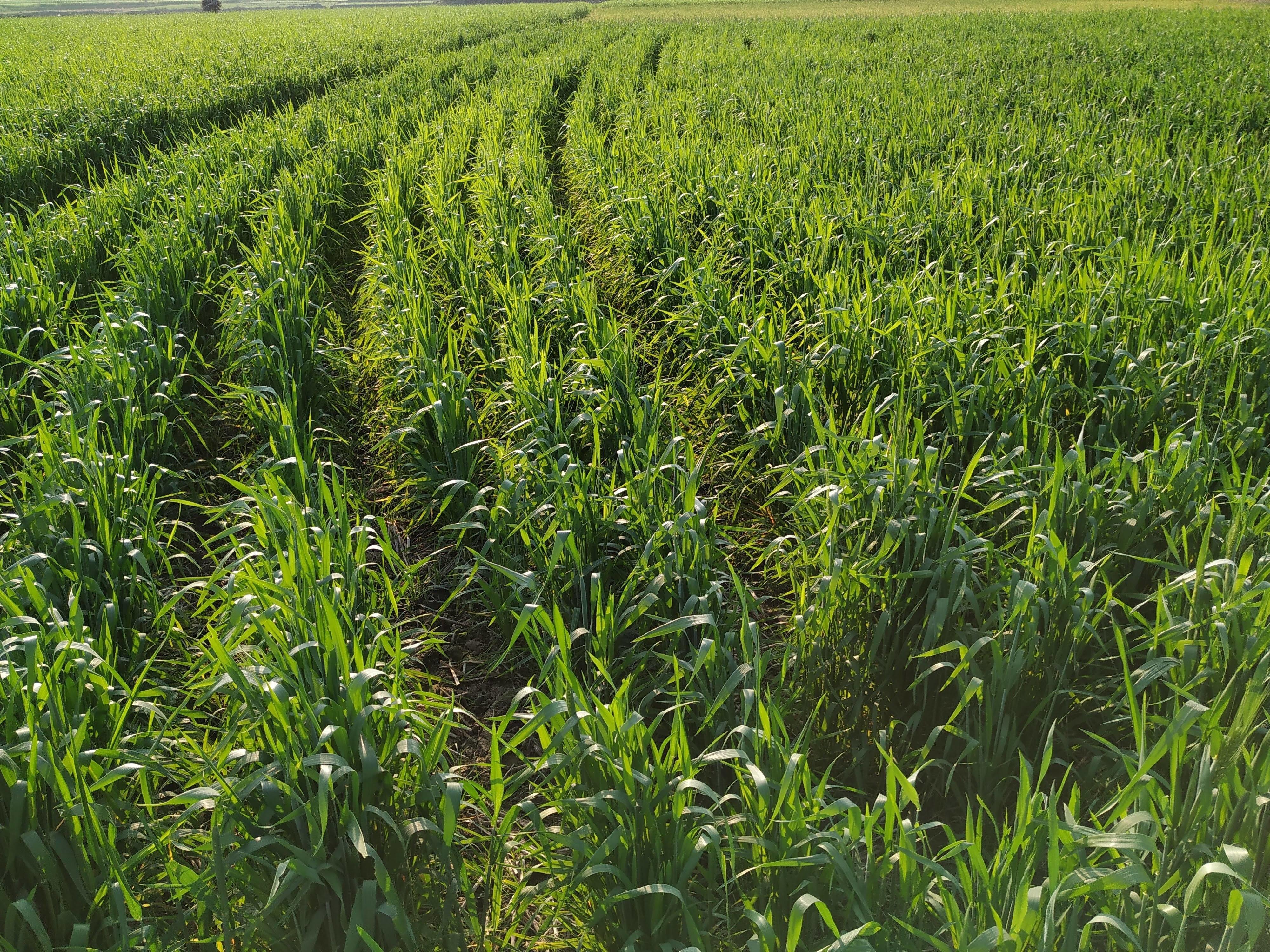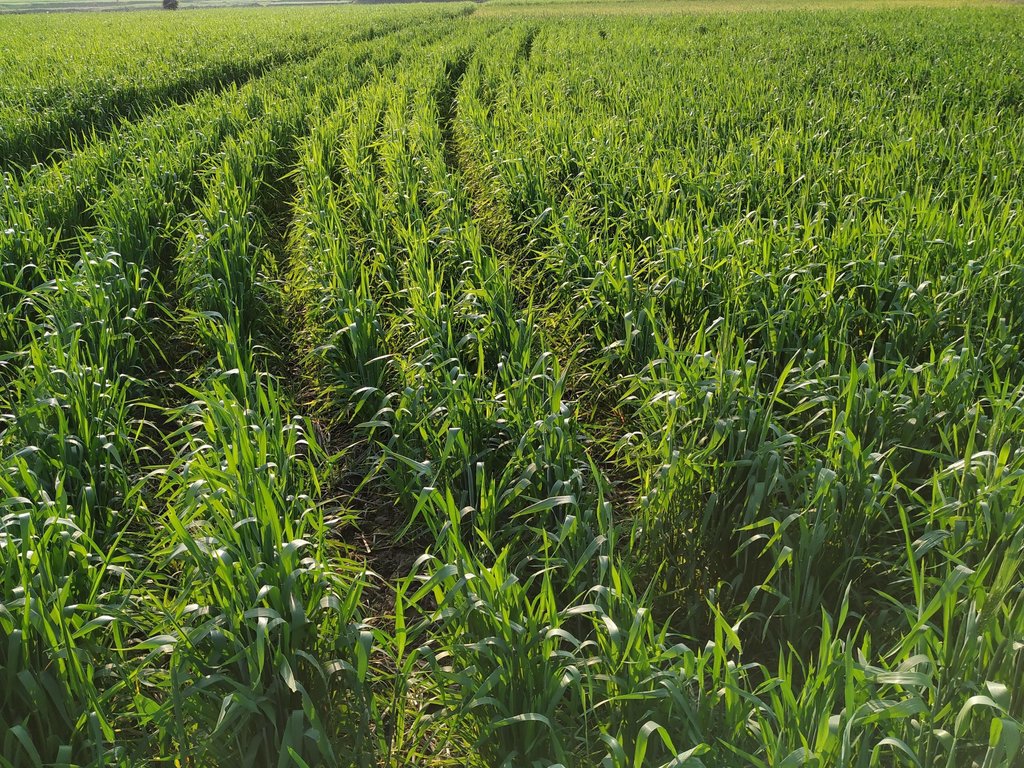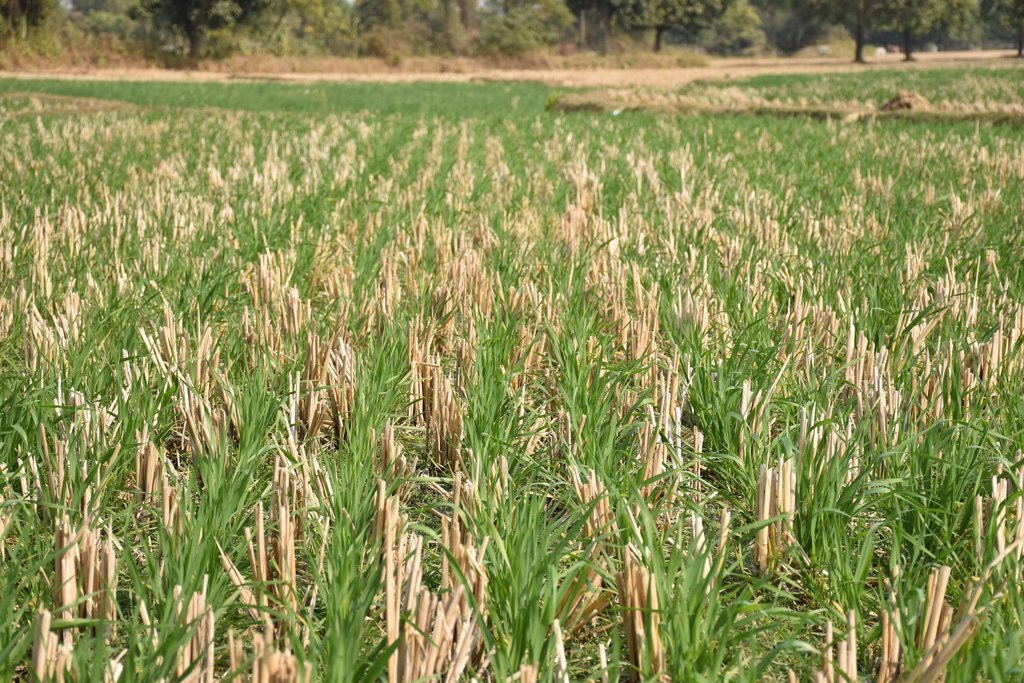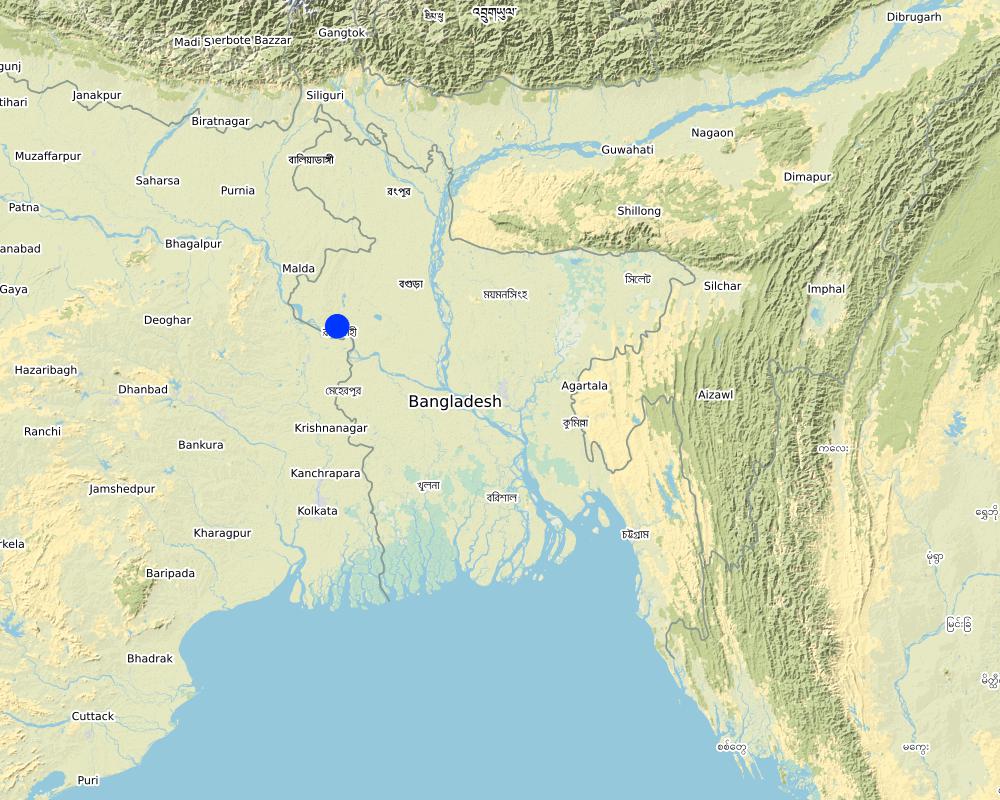Strip tillage wheat production in degraded terraces of High Barind Tract, Rajshahi [Bangladesh]
- Creation:
- Update:
- Compiler: Mutasim Billah
- Editor: Matieu Henry
- Reviewers: Nicole Harari, Rima Mekdaschi Studer, Ursula Gaemperli
Barendra Bhumite sarite gom abad
technologies_4670 - Bangladesh
View sections
Expand all Collapse all1. General information
1.2 Contact details of resource persons and institutions involved in the assessment and documentation of the Technology
land user:
Islam Md. Serajul
Farmer
Bangladesh
co-compiler:
Roy Tapan
Department of Agricultural Extension (DAE), Paba, Rajshshi
Bangladesh
Name of project which facilitated the documentation/ evaluation of the Technology (if relevant)
Decision Support for Mainstreaming and Scaling out Sustainable Land Management (GEF-FAO / DS-SLM)Name of the institution(s) which facilitated the documentation/ evaluation of the Technology (if relevant)
FAO Bangladesh (FAO Bangladesh) - BangladeshName of the institution(s) which facilitated the documentation/ evaluation of the Technology (if relevant)
Department of Agricultural Extension (DAE) - Bangladesh1.3 Conditions regarding the use of data documented through WOCAT
The compiler and key resource person(s) accept the conditions regarding the use of data documented through WOCAT:
Ja
1.4 Declaration on sustainability of the described Technology
Is the Technology described here problematic with regard to land degradation, so that it cannot be declared a sustainable land management technology?
Nee
2. Description of the SLM Technology
2.1 Short description of the Technology
Definition of the Technology:
Strip tillage wheat cultivation is a climate-smart technology to save water and improve soil health
2.2 Detailed description of the Technology
Description:
The High Barind Tract (HBT) situated in north-western region of Bangladesh consisting Rajshahi, Chapai Nawabganj and Naogaon Districts where the underlying Madhupur clay soil has been uplifted and cut into by deep valleys. The topsoil of HBT is grey silt loam to silty clay loam, is strongly puddled and has a compact ploughpan at the base. Deep grey terrace soils and grey valley soil are the major components of the general soil types of this area.
Strip tillage wheat cultivation is being adopted in farmers field on which wheat has been cultivated for decades. Bangladesh Agricultural Research Institute (BARI) developed this technology/innovation, and Department of Agricultural Extension (DAE) and International Maize and Wheat Improvement Center (CIMMYT) disseminated the technology also among farmers of Rajshahi region. In brief, strip tillage wheat is a water saving technology, and requires wheat to be planted in rows. Traditionally, farmers cultivated wheat using the broadcast method, after deep tilling the land 3-4 times and after flood irrigation. In this new method, farmers can use a strip tiller that sows seeds and fertilizer simultaneously immediately after T. Aman rice (Transplanted rice, Aman is the Kharif 2 season from June to November) harvesting. This implies that retained soil moisture can germinate the wheat seeds. Because the wheat seeds are sown in a row, sunlight and air penetrate very well; and weed infestation remains low because of minimum tillage. Farmers report that rodent infestation in strip tillage is lower than conventional broadcast cultivation.
As stated, a strip tiller is needed for this operation, and the machine is a modified version of traditional power tiller developed by BARI. The tiller has thin ploughs in parallel rows (four to a machine), and drops the fertilizer and seed – another wheel-like device presses the seed into the soil. The other parts of land remain unplowed that keep moisture and resist weeds to grow. Retention of rice crop residue increases soil organic matter which in turn increases the soil water retention/holding capacity and loosens the soil (for free drainage).
Overall, this water saving technology has increased livelihood options for tiller machine service providers, decreased on-farm input costs (e.g., irrigation, rodenticide), and increased wheat productivity (by improve weather – storm/wind – resistance of crops and reducing rodent infestation). Moreover, it produces quality wheat, increases the grain weight, and makes wheat easy to harvest. The yield of strip cultivated wheat is reported to be 1.25 times higher than conventional wheat.
2.3 Photos of the Technology
2.5 Country/ region/ locations where the Technology has been applied and which are covered by this assessment
Country:
Bangladesh
Region/ State/ Province:
Rajshahi
Further specification of location:
Paba
Specify the spread of the Technology:
- evenly spread over an area
Is/are the technology site(s) located in a permanently protected area?
Nee
Comments:
Farmers are cultivating strip tillage wheat in their own field
Map
×2.6 Date of implementation
Indicate year of implementation:
2016
If precise year is not known, indicate approximate date:
- less than 10 years ago (recently)
2.7 Introduction of the Technology
Specify how the Technology was introduced:
- through land users' innovation
- as part of a traditional system (> 50 years)
- during experiments/ research
- through projects/ external interventions
Comments (type of project, etc.):
Wheat cultivated in HBT since long ago and the farmer often faced high input cost in traditional cultivation method. BARI Regional Research Station conducted a lot of research on wheat to minimise the input cost and gaining more yield through different projects with farmer. With the help of local farmer, BARI, CIMMYT and DAE demonstrated improved technology for wheat. After trial and trial BARI scientist and the enlisted local service provider developed the light power tiller driven device for strip tillage wheat cultivation.
3. Classification of the SLM Technology
3.1 Main purpose(s) of the Technology
- improve production
- reduce, prevent, restore land degradation
- reduce risk of disasters
- mitigate climate change and its impacts
- create beneficial economic impact
3.2 Current land use type(s) where the Technology is applied
Land use mixed within the same land unit:
Nee

Cropland
- Annual cropping
Annual cropping - Specify crops:
- cereals - rice (wetland)
- cereals - wheat (spring)
- legumes and pulses - beans
- Legume: eg. Mung bean. (T.Aman rice - Wheat - Mung bean)
Number of growing seasons per year:
- 3
Specify:
Wetland rice - wheat - pulse
Is intercropping practiced?
Nee
Is crop rotation practiced?
Ja
If yes, specify:
rice than wheat than pulse
3.3 Has land use changed due to the implementation of the Technology?
Has land use changed due to the implementation of the Technology?
- No (Continue with question 3.4)
Land use mixed within the same land unit:
Nee
3.4 Water supply
Water supply for the land on which the Technology is applied:
- mixed rainfed-irrigated
Comments:
Barind Multipurpose Development Authority (BMDA) established deep tubewell for irrigation to farmers. Generally, farmer use deep tubewell water for irrigation. Also, farmer use surface water from canal for irrigation purpose.
3.5 SLM group to which the Technology belongs
- rotational systems (crop rotation, fallows, shifting cultivation)
- improved ground/ vegetation cover
- minimal soil disturbance
3.6 SLM measures comprising the Technology

agronomic measures
- A1: Vegetation/ soil cover
- A2: Organic matter/ soil fertility
- A3: Soil surface treatment
- A6: Residue management
A3: Differentiate tillage systems:
A 3.2: Reduced tillage (> 30% soil cover)
A6: Specify residue management:
A 6.4: retained

structural measures
- S1: Terraces

management measures
- M2: Change of management/ intensity level
- M4: Major change in timing of activities
3.7 Main types of land degradation addressed by the Technology

soil erosion by water
- Wt: loss of topsoil/ surface erosion

soil erosion by wind
- Et: loss of topsoil

chemical soil deterioration
- Cn: fertility decline and reduced organic matter content (not caused by erosion)

physical soil deterioration
- Pc: compaction
- Pi: soil sealing
- Pw: waterlogging
- Ps: subsidence of organic soils, settling of soil

biological degradation
- Bc: reduction of vegetation cover
- Bq: quantity/ biomass decline
- Bl: loss of soil life

water degradation
- Hs: change in quantity of surface water
- Hg: change in groundwater/aquifer level
- Hp: decline of surface water quality
- Hq: decline of groundwater quality
3.8 Prevention, reduction, or restoration of land degradation
Specify the goal of the Technology with regard to land degradation:
- prevent land degradation
4. Technical specifications, implementation activities, inputs, and costs
4.1 Technical drawing of the Technology
Technical specifications (related to technical drawing):
Machine and device used: Two wheel drive walking type power tiller and attached strip tiller device
Row to row distance: 20 cm
Plant to plant distance: 5 cm (mainly keep continuous seeding)
Depth of row: 5 cm
Crop residue: paddy straw
Author:
Md. Mutasim Billah
Date:
17/04/2019
4.2 General information regarding the calculation of inputs and costs
Specify how costs and inputs were calculated:
- per Technology area
Indicate size and area unit:
Bigha
If using a local area unit, indicate conversion factor to one hectare (e.g. 1 ha = 2.47 acres): 1 ha =:
1 Hectare = 7.48 Bigha
Specify currency used for cost calculations:
- USD
Indicate average wage cost of hired labour per day:
USD 4.7
4.3 Establishment activities
Comments:
No establishment cost needed, because it is a short term annual crop
4.5 Maintenance/ recurrent activities
| Activity | Timing/ frequency | |
|---|---|---|
| 1. | Herbicide application in field | November - December |
| 2. | Seed treatment | November - December |
| 3. | Tillage (Strip) and seed sowing | November - December |
| 4. | Fertilizer application | November - December |
| 5. | Irrigation | January - March |
| 6. | Pesticide application | January - February |
| 7. | Harvesting | April |
| 8. | Threshing | April |
Comments:
At best 2 irrigation is needed depending on soil moisture
4.6 Costs and inputs needed for maintenance/ recurrent activities (per year)
| Specify input | Unit | Quantity | Costs per Unit | Total costs per input | % of costs borne by land users | |
|---|---|---|---|---|---|---|
| Labour | Herbicide application | Person-day | 1.0 | 4.7 | 4.7 | 100.0 |
| Labour | Harvesting | Person-day | 5.0 | 4.7 | 23.5 | 100.0 |
| Labour | Threshing | Person-day | 2.0 | 4.7 | 9.4 | 100.0 |
| Equipment | Two wheel strip tiller | Rent-Bigha | 1.0 | 5.88 | 5.88 | 100.0 |
| Equipment | Irrigation and its equipment charge | Day | 3.0 | 4.11 | 12.33 | 100.0 |
| Plant material | Wheat seed | Kg | 18.0 | 0.59 | 10.62 | 100.0 |
| Fertilizers and biocides | Fertilizer | kg | 70.0 | 0.26 | 18.2 | 100.0 |
| Fertilizers and biocides | Herbicide | Kg | 0.4 | 4.5 | 1.8 | 100.0 |
| Fertilizers and biocides | Seed treatment chemicals | Kg | 0.5 | 4.0 | 2.0 | 100.0 |
| Fertilizers and biocides | Pesticide | Kg | 3.0 | 3.26 | 9.78 | 100.0 |
| Total costs for maintenance of the Technology | 98.21 | |||||
| Total costs for maintenance of the Technology in USD | 98.21 | |||||
4.7 Most important factors affecting the costs
Describe the most determinate factors affecting the costs:
Time of seed sowing: the yield will reduce after 30 November
Irrigation: it is critical in tillering and penicle initiation stage, the yield may reduced. The source of irrigation is BMDA deep tubewell and from canal.
5. Natural and human environment
5.1 Climate
Annual rainfall
- < 250 mm
- 251-500 mm
- 501-750 mm
- 751-1,000 mm
- 1,001-1,500 mm
- 1,501-2,000 mm
- 2,001-3,000 mm
- 3,001-4,000 mm
- > 4,000 mm
Specify average annual rainfall (if known), in mm:
1410.00
Specifications/ comments on rainfall:
Average rainfall in High Barind Tract is much lower than other parts of country
Indicate the name of the reference meteorological station considered:
Weather Atlas; {https://www.weather-atlas.com/en/bangladesh/rajshahi-climate#rainfall}
Agro-climatic zone
- sub-humid
5.2 Topography
Slopes on average:
- flat (0-2%)
- gentle (3-5%)
- moderate (6-10%)
- rolling (11-15%)
- hilly (16-30%)
- steep (31-60%)
- very steep (>60%)
Landforms:
- plateau/plains
- ridges
- mountain slopes
- hill slopes
- footslopes
- valley floors
Altitudinal zone:
- 0-100 m a.s.l.
- 101-500 m a.s.l.
- 501-1,000 m a.s.l.
- 1,001-1,500 m a.s.l.
- 1,501-2,000 m a.s.l.
- 2,001-2,500 m a.s.l.
- 2,501-3,000 m a.s.l.
- 3,001-4,000 m a.s.l.
- > 4,000 m a.s.l.
Indicate if the Technology is specifically applied in:
- convex situations
5.3 Soils
Soil depth on average:
- very shallow (0-20 cm)
- shallow (21-50 cm)
- moderately deep (51-80 cm)
- deep (81-120 cm)
- very deep (> 120 cm)
Soil texture (topsoil):
- fine/ heavy (clay)
Soil texture (> 20 cm below surface):
- fine/ heavy (clay)
Topsoil organic matter:
- low (<1%)
5.4 Water availability and quality
Ground water table:
5-50 m
Availability of surface water:
poor/ none
Water quality (untreated):
good drinking water
Water quality refers to:
ground water
Is water salinity a problem?
Nee
Is flooding of the area occurring?
Nee
Comments and further specifications on water quality and quantity:
Both irrigation and drinking water extracted from deep tubewell of Barind Multipurpose Development Authority (BMDA)
5.5 Biodiversity
Species diversity:
- low
Habitat diversity:
- low
5.6 Characteristics of land users applying the Technology
Sedentary or nomadic:
- Sedentary
Market orientation of production system:
- subsistence (self-supply)
- mixed (subsistence/ commercial)
Off-farm income:
- less than 10% of all income
Relative level of wealth:
- very poor
- poor
Individuals or groups:
- individual/ household
Level of mechanization:
- manual work
- mechanized/ motorized
Gender:
- men
Age of land users:
- middle-aged
- elderly
5.7 Average area of land used by land users applying the Technology
- < 0.5 ha
- 0.5-1 ha
- 1-2 ha
- 2-5 ha
- 5-15 ha
- 15-50 ha
- 50-100 ha
- 100-500 ha
- 500-1,000 ha
- 1,000-10,000 ha
- > 10,000 ha
Is this considered small-, medium- or large-scale (referring to local context)?
- small-scale
5.8 Land ownership, land use rights, and water use rights
Land ownership:
- individual, titled
Land use rights:
- individual
Water use rights:
- communal (organized)
- individual
Are land use rights based on a traditional legal system?
Ja
Specify:
Most of the land owned by land lord and they give taxes to government in year basis. The land owner lease the land to small, marginal and landless farmer in year basis. The land owner take money from them, and sometimes land owner share the crop with lease-taking farmer.
5.9 Access to services and infrastructure
health:
- poor
- moderate
- good
education:
- poor
- moderate
- good
technical assistance:
- poor
- moderate
- good
employment (e.g. off-farm):
- poor
- moderate
- good
markets:
- poor
- moderate
- good
energy:
- poor
- moderate
- good
roads and transport:
- poor
- moderate
- good
drinking water and sanitation:
- poor
- moderate
- good
financial services:
- poor
- moderate
- good
6. Impacts and concluding statements
6.1 On-site impacts the Technology has shown
Socio-economic impacts
Production
crop production
crop quality
risk of production failure
production area
land management
Water availability and quality
irrigation water availability
demand for irrigation water
Income and costs
expenses on agricultural inputs
farm income
diversity of income sources
workload
Socio-cultural impacts
food security/ self-sufficiency
SLM/ land degradation knowledge
Ecological impacts
Water cycle/ runoff
water quantity
excess water drainage
groundwater table/ aquifer
evaporation
Soil
soil moisture
soil cover
soil loss
soil crusting/ sealing
soil compaction
nutrient cycling/ recharge
soil organic matter/ below ground C
Biodiversity: vegetation, animals
Vegetation cover
biomass/ above ground C
pest/ disease control
Comments/ specify:
Rodent infestation decreased
Climate and disaster risk reduction
drought impacts
emission of carbon and greenhouse gases
micro-climate
6.2 Off-site impacts the Technology has shown
water availability
groundwater/ river pollution
impact of greenhouse gases
6.3 Exposure and sensitivity of the Technology to gradual climate change and climate-related extremes/ disasters (as perceived by land users)
Gradual climate change
Gradual climate change
| Season | increase or decrease | How does the Technology cope with it? | |
|---|---|---|---|
| annual temperature | increase | well | |
| seasonal temperature | summer | increase | well |
| annual rainfall | decrease | well | |
| seasonal rainfall | summer | decrease | well |
Climate-related extremes (disasters)
Meteorological disasters
| How does the Technology cope with it? | |
|---|---|
| tropical storm | moderately |
| tornado | not known |
Climatological disasters
| How does the Technology cope with it? | |
|---|---|
| drought | very well |
Biological disasters
| How does the Technology cope with it? | |
|---|---|
| insect/ worm infestation | very well |
6.4 Cost-benefit analysis
How do the benefits compare with the establishment costs (from land users’ perspective)?
Short-term returns:
positive
Long-term returns:
very positive
How do the benefits compare with the maintenance/ recurrent costs (from land users' perspective)?
Short-term returns:
very positive
Long-term returns:
very positive
6.5 Adoption of the Technology
- 1-10%
Of all those who have adopted the Technology, how many did so spontaneously, i.e. without receiving any material incentives/ payments?
- 11-50%
Comments:
Some farmer got seed and sowing cost as incentive, but this number is too small (1-2%) from DAE. Most of the farmer grow wheat without any incentive.
6.6 Adaptation
Has the Technology been modified recently to adapt to changing conditions?
Nee
6.7 Strengths/ advantages/ opportunities of the Technology
| Strengths/ advantages/ opportunities in the land user’s view |
|---|
|
- Low input cost that save plowing cost - Low water requirement |
| - No rodent infestation because of line sowing |
| - High yield |
| Strengths/ advantages/ opportunities in the compiler’s or other key resource person’s view |
|---|
| - Low GHG emission |
|
- Low input cost - Have scope for women engagement, especially in harvesting and threshing purpose |
|
- Increase soil health - Increase the organic matter through crop residue retention |
6.8 Weaknesses/ disadvantages/ risks of the Technology and ways of overcoming them
| Weaknesses/ disadvantages/ risks in the land user’s view | How can they be overcome? |
|---|---|
| Need machinery for this practice | Rent machinery |
| Weaknesses/ disadvantages/ risks in the compiler’s or other key resource person’s view | How can they be overcome? |
|---|---|
| - Timely seed sowing | - Short duration crop cultivation |
7. References and links
7.1 Methods/ sources of information
- field visits, field surveys
5
- interviews with land users
4
- interviews with SLM specialists/ experts
3
When were the data compiled (in the field)?
14/02/2019
7.2 References to available publications
Title, author, year, ISBN:
STATUS OF CONSERVATION AGRICULTURE BASED TILLAGE TECHNOLOGY FOR CROP PRODUCTION IN BANGLADESH; M. ISRAIL HOSSAIN, M. J. U. SARKER AND M. ARSHADUL HAQUE; 2015; ISSN 0258-7122
Available from where? Costs?
Internet, free
7.3 Links to relevant online information
Title/ description:
STATUS OF CONSERVATION AGRICULTURE BASED TILLAGE TECHNOLOGY FOR CROP PRODUCTION IN BANGLADESH
URL:
https://www.banglajol.info/index.php/BJAR/.../16658
Links and modules
Expand all Collapse allLinks
No links
Modules
No modules







